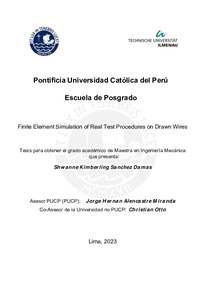| dc.contributor.advisor | Alencastre Miranda, Jorge Hernan | |
| dc.contributor.author | Sanchez Damas, Shwanne Kimberling | |
| dc.date.accessioned | 2024-04-17T16:41:09Z | |
| dc.date.available | 2024-04-17T16:41:09Z | |
| dc.date.created | 2023 | |
| dc.date.issued | 2024-04-17 | |
| dc.identifier.uri | http://hdl.handle.net/20.500.12404/27579 | |
| dc.description.abstract | La simulación por elementos finitos se ha convertido en una herramienta clave para el análisis y optimización
de procesos de ingeniería, ya que permite el análisis de un gran número de condiciones a un
coste relativamente bajo. En este trabajo se ha utilizado esta herramienta para el análisis de un proceso
de trefilado multietapa, así como para la implementación de ensayos de tracción y torsión en dichos
alambres trefilados. El objetivo es evaluar los diferentes modelos de endurecimiento para el proceso de
trefilado y para los ensayos de prueba señalados. Se ha realizado la simulación del ensayo de tracción
del alambre tras cada etapa de trefilado y se ha automatizado la obtención de los parámetros mecánicos
más importantes. Luego, estos se han contrastado con valores experimentales para analizar los resultados
obtenidos con los diferentes modelos de endurecimiento. Asimismo, los valores de daño se calculan
según los criterios de Cockroft y Latham para el proceso de trefilado, para el ensayo de tracción y adicionalmente
se calcula el daño total en el alambre, es decir el daño generado debido al trefilado después
de cada etapa juntamente con el daño generado por el ensayo de prueba. Todos estos procedimientos se
han realizado utilizando diferentes modelos de endurecimiento seleccionados. Finalmente se analizan
los resultados obtenidos, se presentan las conclusiones y la proyección de perspectivas para futuros
estudios. | es_ES |
| dc.description.abstract | Finite element simulation has become a key tool for the analysis and optimization of engineering processes,
since it allows the analysis of a large number of conditions at a relatively low cost. In this work,
this tool has been used for the analysis of a multistage wire drawing process as well as for the implementation
of tensile and torsion tests. The objective is to evaluate different hardening models for the
wire drawing process and for the tests procedures. The simulation of the tensile test has been carried out
for the wire after each drawing stage and the obtaining of the most important mechanical parameters has
been automated. Then, these are contrasted with experimental values in order to analyze the results
obtained with the different hardening models. Likewise, the damage values are calculated according to
the Cockroft and Latham criteria for the drawing process, for the tensile test and the total damage in the
wire after each stage of the drawn and tested wire. All these procedures have been carried out using
different selected hardening models. Finally, the results obtained are analyzed, the conclusions obtained
and the projection of perspectives for future studies are presented. | es_ES |
| dc.description.abstract | Die Finite-Elemente-Simulation ist zu einem Schlüsselwerkzeug für die Analyse und Optimierung von
Engineering-Prozessen geworden, da sie die Analyse einer großen Anzahl von Bedingungen zu relativ
geringen Kosten ermöglicht. In dieser Arbeit wurde dieses Tool zur Analyse eines mehrstufigen
Drahtziehprozesses sowie zur Durchführung von Zug- und Torsionsversuchen eingesetzt. Ziel ist es,
verschiedene Verfestigungsmodelle für den Drahtziehprozess und Prüfverfahren zu evaluieren. Die
Simulation des Zugversuchs wurde für den Draht nach jeder Ziehstufe durchgeführt und die Ermittlung
der wichtigsten mechanischen Parameter automatisiert. Anschließend werden diese mit Messwerten
verglichen, um die mit den unterschiedlichen Verfestigungsmodellen erzielten Ergebnisse zu
analysieren. Ebenso werden die Schädigungswerte nach den Kriterien von Cockroft und Latham für den
Drahtziehprozess, für den Zugversuch und die Gesamtschädigung im Draht nach jeder Stufe des
gezogenen und geprüften Drahtes berechnet. Alle diese Verfahren wurden mit den verschiedenen
ausgewählten Verfestigungsmodellen durchgeführt. Abschließend werden die erzielten Ergebnisse
analysiert, die gewonnenen Schlussfolgerungen und die Projektion von Perspektiven für die zukünftige
Forschung präsentiert. | es_ES |
| dc.language.iso | eng | es_ES |
| dc.publisher | Pontificia Universidad Católica del Perú | es_ES |
| dc.rights | info:eu-repo/semantics/closedAccess | es_ES |
| dc.subject | Método de elementos finitos | es_ES |
| dc.subject | Alambres | es_ES |
| dc.subject | Mecánica | es_ES |
| dc.title | Finite element simulation of real test procedures on drawn wires | es_ES |
| dc.type | info:eu-repo/semantics/masterThesis | es_ES |
| thesis.degree.name | Maestro en Ingeniería Mecánica | es_ES |
| thesis.degree.level | Maestría | es_ES |
| thesis.degree.grantor | Pontificia Universidad Católica del Perú. Escuela de Posgrado. | es_ES |
| thesis.degree.discipline | Ingeniería Mecánica | es_ES |
| renati.advisor.dni | 10588073 | |
| renati.advisor.orcid | https://orcid.org/0000-0001-8442-8255 | es_ES |
| renati.author.dni | 74166051 | |
| renati.discipline | 713347 | es_ES |
| renati.juror | Rodriguez Hernandez, Jorge Antonio | es_ES |
| renati.juror | Alencastre Miranda, Jorge Hernan | es_ES |
| renati.juror | Barriga Gamarra, Eliseo Benjamin | es_ES |
| renati.level | https://purl.org/pe-repo/renati/level#maestro | es_ES |
| renati.type | https://purl.org/pe-repo/renati/type#tesis | es_ES |
| dc.publisher.country | PE | es_ES |
| dc.subject.ocde | https://purl.org/pe-repo/ocde/ford#2.03.01 | es_ES |






